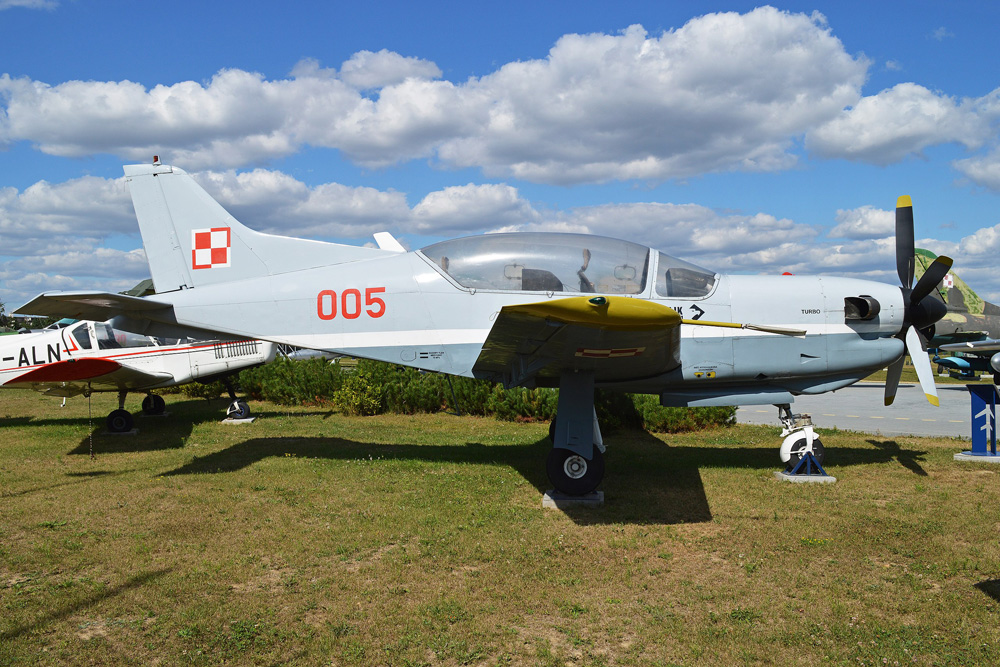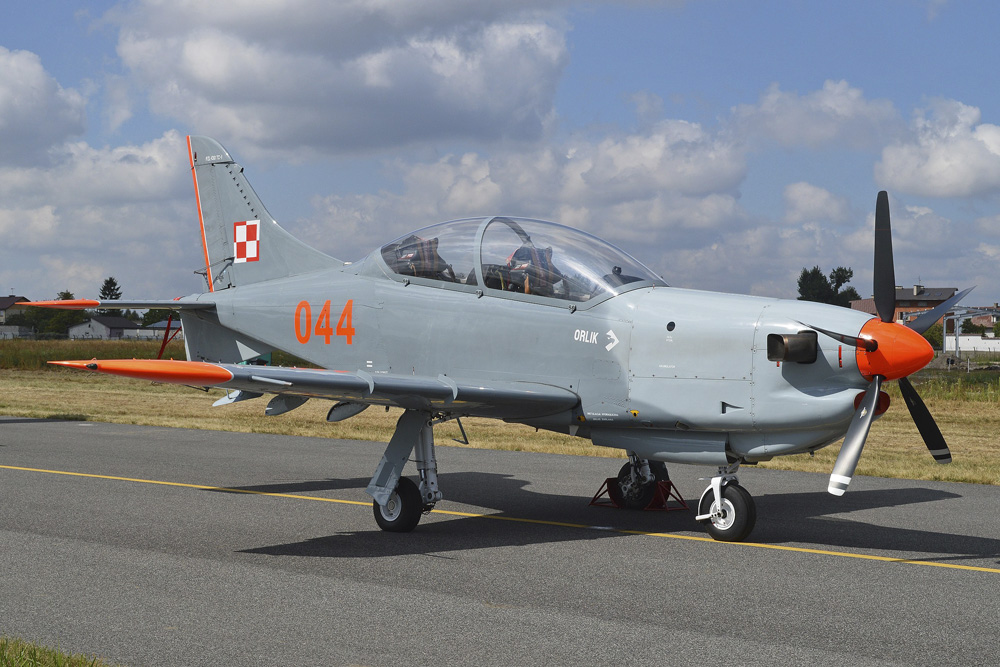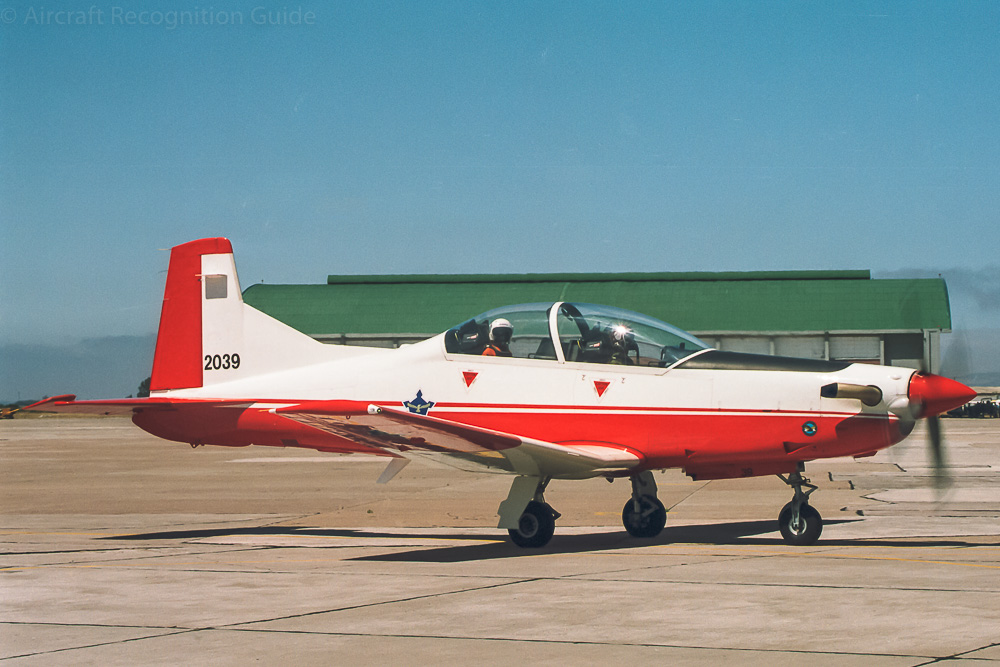
PZL130 Orlik
This aircraft is the primary trainer of the Polish military, that has its origins in the 1980s. The PZL130 is quite a small aircraft compared to other aircraft in the category of high performance prop trainers. It has straight low wings with continuous dihedral mated to a slender fuselage with a tandem cockpit. The canopy opens sideways in a single piece. At the rear is a conventional tail. Kind of typical is the trailing link main gear with long legs. Is comes in versions with a radial piston engine and turboprop engine.
Different versions
The different versions of the PZL130 can be recognised by:
- the presence of winglets
- the shape of the nose
- the presence of a head-up display (HUD)
- the shape of the canopy
- the shape of the vertical stabiliser
- the presence of ejection seats
- the presence of a ventral fin
- the number of propeller blades
- the shape of the exhausts
PZL130 Orlik
As the Polish air force wanted a piston powered aircraft, the first version of the PZL130 had a radial engine up front, recognisable by the blunt nose shape. The canopy consists of three parts with a bow frame in front of student and instructor pilots. Both sit at the same level, in non-ejecting seats. The vertical stabiliser and drosal fin have nearly straight edges.
The original PZL130 has a radial engine in the nose.
PZL130T Turbo Orlik
From the start PZL envisioned a turboprop powered version of the PZL130. This was a PT6A engine with a three blade propeller. Due to the different engine the nose is more pointed. Typical is the streamline body in front of the nose gear. Another change compared to the PZL130 is the removal of the rear bow frame of the canopy, so only the front one remains.
The Turbo Orlik has a turboprop driving a three blade prop. The canopy has a single bow frame in front of the front seat.
PZL130TB & PZL130TM Orlik
Both are version with an alternative engine, different variants of the Walter M601. These engines have slightly different exhausts, but still at the side of the nose. The PZL130TB and TM have five blade props. For the rest they are externally the same as the PZL130T.
The PZL130TM is externally the same as the PZL130T except for the five blade prop and exhausts. (photo: Alan Wilson/WikiMedia)
PZL130TC-I Orlik
The Walter M601 also powers the five blade prop of the PZL130TC-I, but the airframe was redesigned. The rear seat is higher than the front seat and the bow frame has moved to in between the pilots. Additionally, the leading edge of the vertical stabiliser and dorsal fin are curved. Finally, a ventral fin was added.
The PZL130TC-I can be recognised from the later TC-II by the five blade prop and absence of winglets. (photo: Dura-Ace/WikiMedia)
PZL130TC-II
On the PZL130TC-II the manufacturer changed back to the Pratt & Whitney PT6A engine. this has slightly longer exhausts than the Walter engine. More obvious external differences are the four blade propeller and winglets (or actually more bent-up wing tips).
Compared to the PZL130TC-I above the PZL130TC-II has a four blade prop and small winglets.
PZL130TC-III
The PZL130TC-III is an updated version of the TC-II. It has a head-up display (HUD) as addition, so this is the way to recognise the variant.
Compared to the PZL130TC-II the III has a HUD, head-up display.
Confusion possible with
TAI Hürkuş
The PZL130 has many characteristics of the Hürkuş, especially the TC-II version thanks to the winglets. If you look well you see that the fin of the Turkish trainer has a large triangular dorsal fin. Also the air intake is less separated from the prop spinner.
Pilatus PC-21
The successor of the PC-9 has a two piece canopy much similar to that of the Orlik, and also wings with constant (small) dihedral and slightly bent-up wing tips. Different are the non-curved leading edge of vertical stabiliser and air intake close to the spinner.
Pilatus PC-7 MkII/PC-9M
The PC-7 and PC-9 have inner wings with no dihedral, whereas the PZL-130 has ones with continuous dihedral. Also the tail is different as is the nose.
Pilatus P-3

The P-3 was the piston powered predecessor of the PC-7. Both have similar lines, except for the wider nose. The P-3 also has a four piece canopy.
KAI KT-1 Woong-Bee

This Korean aircraft also resembles the Orlik, in particular the canopy. However, the KT-1 has a much smaller dorsal fin, no ventral fin, and the nose gear doors are shorter. (photo: Alto Bidini/WikiMedia)
Beech T-6 Texan II
Being derived from the Pilatus PC-9 it is logical that it share a lot of similarities with the Texan II. So the main differences with the Orlik are similar: the dorsal fin of the T-6 is much smaller and the inner wings have no dihedral.









